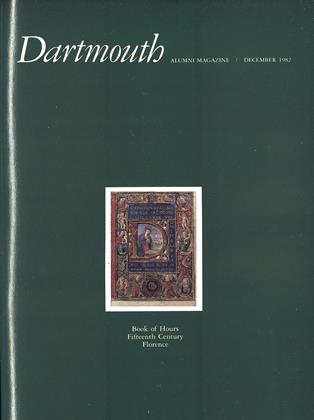ISLANDS OF THE MID-MAINE COAST:BLUE HILL AND PENOBSCOT BAYS by Charles B. McLane '41 The Kennebec River Press, 1982. 508 pp. $35.00
For three centuries before postroads and railroads connected the North Country to the rest of the evolving nation, island Maine was mainline Maine. Maine ships carried cargoes of granite to cities. The piers of the Brooklyn Bridge, the Kennedy Memorial in Arlington Cemetery, the curbstones and buildings of many older cities are parts of islands in the Blue Hill and Penobscot bays.
The people who settled the islands were hardy farmers, fishers, stonecutters, and quarriers. This fine book distills their essences and has a stronger flavor than that of general history. It has been put together from prodigious research extending over a decade. The author, as intrepid as sailor and historian as he was as ski team captain in his undergraduate days, visited by sailboat most of the 275 islands mentioned. He searched titles and census tracts, catalogued genealogies of island families, and selected photographs, charts, sketches and maps, reproductions of which add greatly to the interest of his book.
McLane presents with wit and sympathy the stories of generations of inhabitants. Take, for example, the legendary disaster of the Royal Tar, lost in Penobscot Bay in an autumn gale in 1836 on a passage from Yarmouth, Nova Scotia, to Boston. The vessel went down with "an assorted menagerie of animals . . . camels, circus horses, two lions, a tiger, a gnu, various other species, and an elephant" and lost 29 of its 72 passengers (including 23 of 28 women and children) and only two of the 20-member crew.
Entrepreneurs, whose tintypes and photographs have the look of caricature, developed the granite quarries, and their tales are told with intriguing details. Imported stonecutters from the British Isles, Scandinavia, and Italy lived under conditions dictated by an iron paternalism in some communities, where the fishing and lobstering populations lived quite other lives.
This book is a delight to read and peruse. It has none of the usual flaws of special pleading which frequently mar regional histories. It combines fascination for readers who know the islands with valuable research data for historians. It was clearly a labor of love for its author, and it has been transmitted with warmth and spirit.
For most of the year Craig Kuhn is an attorneyin Pittsburgh; in the summers he goes DownEast.
 View Full Issue
View Full Issue
More From This Issue
-
 Feature
FeatureOn Building Community
December 1982 By Mary Ellen Donovan -
 Feature
FeatureWhere They Hang Their Hats
December 1982 By Steve Farnsworth and Jean Korelitz -
 Feature
FeatureWindows on a World
December 1982 By Shelby Grantham -
 Article
ArticleDartmouth in the World
December 1982 -
 Article
ArticleRound the Girdled Earth...
December 1982 -
 Article
ArticleTHE DICKEY ENDOWMENT
December 1982










